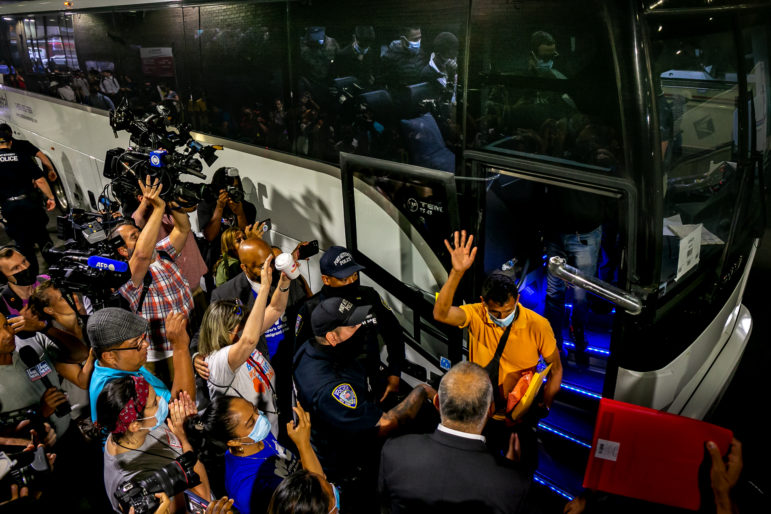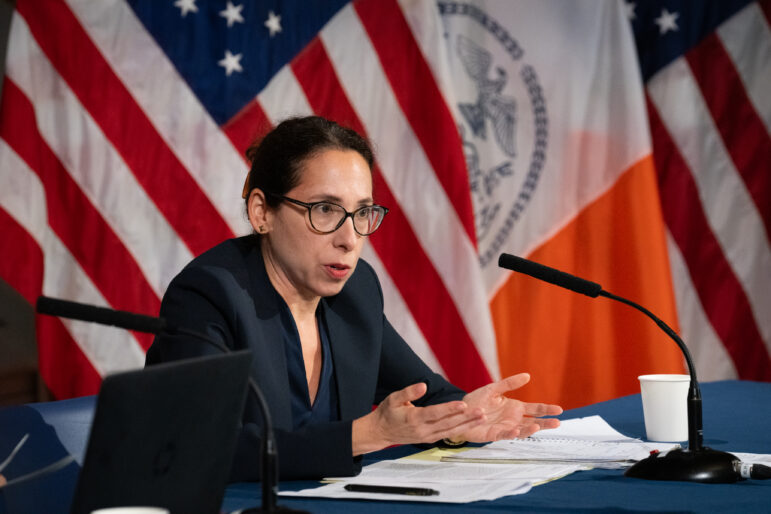In a new state court filing, the Adams administration is requesting authority to suspend the bulk of a 1981 decree that ensures shelter access for single adults.

Adi Talwar
The first person disembarking the first of three buses that arrived from Texas at Port Authority in Midtown Manhattan on Aug. 10, 2022.At a City Hall briefing on Tuesday, Mayor Eric Adams alluded to an impending “shift” in how his administration aims to reduce pressure on the city’s shelter system, which has seen its population more than double since the spring of 2022.
More than 122,000 recently-arrived immigrants have come through New York City’s intake system since that time, according to city officials, and more than 60,000 remain in shelter, pushing the overall population north of 116,000 individuals.
“We are out of room, and we’re getting ready to take a real shift in this whole crisis,” Adams said.
A few hours later, the public got a glimpse of what he meant. As anticipated, his corporation counsel filed a request in state court, seeking new relief from the 1981 consent decree in Callahan v. Carey, a lawsuit that established a right to shelter for single men.
New York City is uniquely obligated to provide a shelter bed to anyone in need, at least temporarily—part of a set of rules that grew from the Callahan decree and subsequent court decisions.
But the Adams administration is now requesting the ability to suspend the bulk of the decree, pertaining to shelter access and standards for single adults, when two conditions are met. First, either the governor or mayor must declare a state of emergency. And second, the daily population of single adults seeking shelter must exceed a set threshold.
According to City Hall, the threshold would be met when, for any two week period during or immediately preceding the state of emergency, the daily number of single adults seeking shelter is at least 50 percent higher than that daily population prior to the state of emergency, averaged over a two-year period.
Adding another wrinkle to the calculation, the two-year period would exclude any times a housing-related state of emergency is in effect. City Hall did not immediately clarify what this would mean in practice.
“This is extreme,” said Deborah Berkman, supervising attorney of the Shelter Advocacy Initiative at New York Legal Assistance Group (NYLAG). “Most New Yorkers today have never seen a city without the right to shelter, and don’t understand how disastrous it will be. People will have no place to go except outside.”
In Tuesday’s letter, the Adams administration said relief from Callahan would allow the city to conduct shelter-eligibility screenings for single adults, in accordance with state law.
Berkman works closely with homeless families in New York City, who are already subject to eligibility screenings and stay in temporary shelter placements while they apply for a more secure placement, often repeatedly.
“People aren’t pretending to be homeless to get shelter,” Berkman said. “This [screening] process is just an administrative burden, it’s costly for the city and state to implement, and it’s a waste of government resources.”
Milton Perez, a leader with the Homeless Union within VOCAL-NY, entered the shelter system as a single adult in 2014. He’s had an apartment of his own since 2021, and says he was deeply frustrated with the bureaucracy of the system, and how hard it was to exit. But the shelter was still preferable to the street.
“When I see people in the street, I would advise them, ‘Hey, if it gets too cold, please take a shot at being actually in some type of shelter, even though I understand how hard it is,’” he said. “At least it’s something. The streets are hard, you know what I’m saying? Deadly.”
During Fiscal Year 2022, a period that includes last winter, 19 homeless New Yorkers died from “exposure to excessive natural cold,” the highest number over the last several years, according to city data.
Ideally, Perez said, New York City would have a right to housing, not just a right to shelter. “The right to shelter is very important,” he said. “It should be right to housing, overall in the U.S., but this is the least that we could do.”
Adams’ request to proceed with a court motion, in the hopes of ultimately modifying the Callahan decree, must be granted by a state court judge.
The Coalition for the Homeless, which represents the interests of homeless New Yorkers in Callahan, will oppose it in court, represented by the Legal Aid Society and Steve Banks, social services commissioner under former Mayor Bill de Blasio.
The parties have been in negotiations, along with lawyers for the state, since the Adams administration first sought to modify Callahan in May.
The Legal Aid Society has pointed to recent developments that could help people leave city shelters, like expedited work eligibility for Venezuelans, as reason not to meddle with shelter rights. But the Adams administration has cited to a recent surge in new arrivals—about 600 per day, some on chartered buses from Texas.
At a press conference Wednesday, Josh Goldfein of Legal Aid said his team will file a reply letter in court next week. If the judge allows the city to proceed, formal motions would follow and, potentially, oral arguments. Litigation could drag on for some time.
For a preview of what the mayor is hoping for, city residents need only look elsewhere in the state, according to Goldfein.
“We have seen over and over again, upstate, that people are turned away from shelters, they are turned into the weather, they are left with nowhere to go,” he said. “That includes people who are working, people who are disabled, people who are unable to get their public assistance case open.”
Under policies implemented this summer, recently-arrived immigrant adults are already subject to limits on their shelter stays—initially 60 days, and now 30. The city has said people can return to an intake shelter if they have no alternative, a backstop that could keep the policy compliant with existing shelter obligations in the near term.
However, Goldfein noted, Legal Aid has received reports of people being turned away, and brought these to the city’s attention. “On the ground we have definitely seen issues with implementation and we continue to monitor them,” he said.
Goldfein also criticized the wording of the administration’s proposed formula for suspending shelter rights for adults.
“The formula they proposed is confusing. I’m not sure it’s operable,” he told City Limits. “I think there are many ways to interpret it, and I think that is one piece of evidence to show how thoughtless this is.”

Lisa Zornberg, general counsel to Mayor Adams, provided little clarity at a press briefing Wednesday, saying subsequent court filings will lay out how the formula will work.
“What I can tell you is that if the relief outlined in the letter were to be imposed or granted today, New York City would meet it,” she added. “That much I can say.”
The letter seeks to distinguish between New York City’s shelter system in 2023, and the conditions in place when Callahan took effect in the 1980s.
“The City requires immediate relief with respect to the most intractable aspect of the present crisis—the global perception that the Consent Judgment extends a blanket right to obtain City-provided shelter to the world at large,” it states.
But advocates pushed back on the perception that people are coming to New York City simply to get a shelter bed.
Berkman of NYLAG said some of her clients were sent to the city by bus, without much autonomy. Many came because they have family in New York, or want to find work here.
“This is the city of dreams,” she said. “This is where people come. None of my clients came here for shelter… people have family here, they want to live in New York, they want to live in a city with a thriving economy.”
To reach the editor behind this story, contact Jeanmarie@citylimits.org. To reach the reporter, contact emma@citylimits.org.








